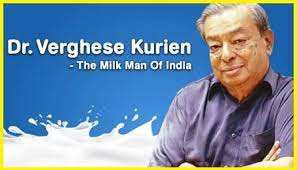Indian Economy
National Milk Day: 26th November
- 27 Nov 2021
- 7 min read
Why in News
Recently, the Ministry of Animal Husbandry & Dairying has celebrated the National Milk Day (NMD) on 26th November.
- National Gopal Ratna Awards were conferred to the winners of the respective stakeholders of Dairy sector and also launched IVF (In Vitro Fertilization) Lab at Dhamrod, Gujarat and Hessarghatta, Karnataka.
- Every year, the first day of June is observed as World Milk Day.
Key Points
- About:
- NMD is celebrated to commemorate the birth Anniversary of Dr. Verghese Kurien (Milk Man of India).
- NMD 2021 commemorates the 100th birth anniversary of Dr. Kurien.
- The day celebrates the importance of milk in a person’s life. And to promote the benefits related to the milk & milk industry and to create awareness among people about the importance of milk and milk products.
- NMD is celebrated to commemorate the birth Anniversary of Dr. Verghese Kurien (Milk Man of India).
- Dr. Verghese Kurien (1921-2012):
- He is known as the ‘Father of White Revolution in India’.
- He is famous for his ‘Operation Flood’, which is known as the world’s largest agricultural program.
- He established 30 institutions that are run by various farmers and workers.

- He also played a key role in the establishment and success of Amul Brand.
- Because of his efforts only, India became the largest producer of milk in 1998, surpassing the U.S.
- He also helped manage the Delhi Milk Scheme and corrected the prices. He also helped India become self-sufficient in edible oils.
- He was honoured with several awards, including the Ramon Magsaysay Award (1963), Krishi Ratna (1986) and World Food Prize (1989).
- He is also the recipient of India's highest civilian awards- Padma Shri (1965), Padma Bhushan (1966) and Padma Vibhushan (1999).
- Operation Flood:
- About:
- It was launched on 13th January, 1970. It was the world's largest dairy development programme.
- Within 30 years, the operation helped double milk available per person in India, making dairy farming India's largest self-sustainable rural employment generator.
- The operation gave farmers direct control over the resources they create, helping them direct their own development. This was achieved not only by mass production, but by production by the masses. It is also now known as the "White Revolution".
- Phases of the White Revolution:
- Phase I (1970-1980): This phase was financed by the sale of butter oil and skimmed milk powder donated by the European Union through the World Food Program.
- Phase II (1981 to 1985): During this phase, the number of milk sheds increased from 18 to 136, milk outlets were expanded to about 290 urban markets, a self-sustaining system was set up that included 4,250,000 milk producers spread across 43,000 village cooperatives.
- Phase III (1985-1996): This phase enabled the dairy cooperatives to expand and gave a finishing touch to the programme. It also strengthened the infrastructure required to procure and market increasing volumes of milk.
- Objectives:
- Increase milk production ("a flood of milk").
- Increase rural incomes.
- Reasonable prices for consumers.
- Significance:
- It helped dairy farmers direct their own development, placing control of the resources they create in their own hands.
- It has helped India become the largest producer of milk in the world in 2016-17.
- Currently, India is the world's largest milk producer, with 22% of global production.
- About:
Indian Dairy Sector
- About:
- India being the world's largest milk producing country, accounts for more than 22.0% of the world and 57% of Asia’s total milk production.
- The milk production of India has grown from 17 million tonnes in 1951 to 187.7 million tonnes in the year 2018-2019.
- Significance:
- Dairy is the only agri-product in which around ~70-80% final market value is shared with farmers and it accounts for approximately one-third of rural household income in India.
- It improves farmer livelihoods, creates jobs, supports agricultural industrialization and commercialization, and enhances nutrition for the masses.
- Challenges:
- Lack of proper packaging and labeling system of milk and milk products.
- Lack of Market Intelligence to understand the mindset of entrepreneurs.
- Consumer perception/Brand Building is also a major challenge.
- Cold chain (transportation) and storage facilities are not effectively in operation.
- Related Initiatives:
- Gopal Ratna Awards: They are National Awards for the Cattle and Dairy sector, the awards have been launched to promote the best herd of Indigenous Breed and practicing best management practices.
- e-Gopala (Generation of wealth through Productive Livestock) App: It is a comprehensive breed improvement marketplace and information portal for direct use of farmers.
- National Action Plan on Dairy Development 2022: It seeks to increase milk production and double the income of dairy farmers.
- National Animal Disease Control Programme & National Artificial Insemination Programme: It was launched to control and eradicate the Foot & Mouth Disease (FMD) and Brucellosis amongst the livestock in the country,
- Pashu-Aadhar: It is a unique ID on a digital platform for traceability for the animals.
- Rashtriya Gokul Mission: It was launched in 2019 for the setting up of 21 Gokul Grams as Integrated Cattle Development Centres.






